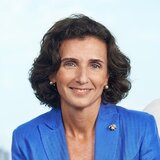- Together with the knowledge of Fundación Metrópoli and the support of the strategic ally Fundación Moeve, this space for meeting and reflection within the Santa Cruz City Project has made it possible to gather feedback from more than 90 local stakeholders
While the First City Forum, held last March, focused on identifying and prioritizing the major issues associated with defining the future of Santa Cruz, the purpose of this second participatory meeting was to gather participants' feedback on fourteen strategic project proposals identified by Fundación Metrópoli. Each of these proposals will serve as a basis for guiding the content of the final version of the Santa Cruz City Project.
During the Second City Forum, representatives from government agencies, political groups, neighborhood associations, professional groups, universities, and companies from the public and private sectors actively participated by contributing their own perspectives. To this end, each participant completed a questionnaire, and these results will be used to provide an idea of the level of acceptance of the proposals presented, as well as adjust and enrich them with nuances and new ideas. Their participation in this discussion space, which brings together technical knowledge, social sensitivity, and institutional commitment, plays a key role in continuing to strengthen a shared vision of the dream city.
The strategic project proposals presented to the participants are grouped around five fundamental pillars, aiming to position Santa Cruz as a more sustainable, innovative, competitive, cohesive, and inclusive city that is fully connected to its natural and maritime environment, integrating local identity with a global vision of smart urban development.
These five areas and the associated initiatives are: Comprehensive planning (Tenerife ecoisland / Metropolitan project), Mobility and transport (Metropolitan beltway / Tram extension), Urban integration and environment (Ecological corridors. Los Barrancos / Central ecoboulevard / Coastal ecoboulevard), Economy and innovation (Buenos Aires innovation district / Selective renovation of industrial estates / Port-city project / Tenerife Intelligence), and Urban and heritage regeneration (Urban renewal of the historic center / Neighborhood hearts / The villas of the Park).
The mayor of Santa Cruz, José Manuel Bermúdez, stated that "what we have done today at the Second City Forum is to move forward in a process that combines specialized knowledge, citizen participation, and political will to coherently define the city model we want for Santa Cruz" and praised "the role of Fundación Moeve as an essential driving force that has made this project economically viable and played an active role in consolidating a model for the city of the future."
The Councilor for Public Services, Strategic Planning, and Environmental Sustainability, Carlos Tarife, indicated that "the Second City Forum marks a fundamental step in building the model of the city we want Santa Cruz to become. Today, together with local stakeholders, we have been able to review a series of strategic projects that will help design a more sustainable, cohesive, and innovative city with a higher quality of life, all through a participatory and open process."
The mayor emphasized that "this project will drive urban transformation and development and enable the capital of Tenerife to tackle the challenges of the 21st century. Following the diagnostic phase, we can now prioritize and finalize strategic projects using this input from all stakeholders."


